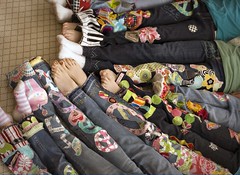
If you're stopping by here today, you're probably hoping to see some needlework or even hear a funny story about how I plan to trick my family this April Fools Day.
But today, I was asked by my fellow Maryland blogger, Meg Fairfax Fielding of Pigtown-Design to post about hunger in America. I won't go into all the statistics about the growth of hunger in America -- suffice it to say that the economic crisis has created a food crisis as well and demand is outstripping supply.
What did the food banks say were the most prominent contributors to increases in demand?
- 91% cited the rising cost of food
- 90.5% cited increasing unemployment
- 67% cited increasing underemployment
To be honest, I had heard that my local food banks were in desperate need. In fact, I felt like I've been contributing. I have made casseroles for my local church and participated in food drives. But what I learned in preparing to write my post for you today is this:
1. I have been helping some, which is good, but not necessarily in a way that helps the food banks most efficiently.
2. My help has not really been much of a sacrifice for my family. It was not noticeable to donate a few extra meals here and there. Was this enough? I learned that it is not.
3. And lastly, the economic crisis has affected my family -- we're not eating out at restaurants and our frivolous spending has stopped. But we certainly haven't gone hungry and we have not changed our menu plans or our food purchases. What if we did?
In order to post for all of you, I had to do some research, and what I learned was interesting. First of all, it's hard for food banks to manage individual food donations which is what I had been doing...this makes sense. Individual donations do not always result in predictable and healthy food supplies and are a challenge to sort, store and distribute. Duh...I hadn't really thought about that but it makes sense. And all the while I was feeling good about the canned goods I was dropping off at Church...
When I called around to some of the food banks in Baltimore City, they said yes they were desperate for food but again, they could only handle organized donations from large groups of people. Don't get me wrong, they will still accept individual donations but I understood what they meant...
When I went to the Feeding America website, they explained that this is their reasoning for creating a Virtual Food Drive. Evidently, food banks have gotten sophisticated and they buy food in bulk so they have tremendous purchasing power, more than me as an individual. Bottom line, they need cash donations more than they need my donations of coffee and canned goods.
Cash. All roads lead back to cash. OK, here we go, another charitable organization that needs money at a time when we don't have any extra. I remember saying to Jim last year, then when the going gets tough for everyone, that's when we'll need to step up and do more. And now, here we are...
The easy answer is "no" because there just isn't any extra spending happening in my household. OR My family could get creative and start to carve out money from a budget that we're already spending on food. Because of April Food Day, I'm going to try a new approach and I might just help out a Maryland family. I mean, a $25 donation can buy 75 meals!!
Tonight at our dinner table, I'm going to challenge my family to think differently about food. The first thing we can do is go after low hanging fruit -- like that jar full of change that probably has about $200 in it. We can turn that into cash and into food for a hungry family and make the donation today.
Secondly, we can change our price per meal within our own family by purchasing more smartly and eating less expensive alternatives. If we can move our price/meal from $25/day to $20/day that leaves $5 extra to donate to needy families moving forward.
These are just two ideas I've come up with off the top of my head. But I'm sure Jim and Jack will have good ideas as well. No, we don't have any extra money around right now, but yes, we can try to include America's hungry families in our household budget.
And, as I reflect on this diagram of Maslow's Hierarchy of Need (thanks to Easy and Elegant Life), I realize I am blessed to live in the penthouse on most days. And I'm all for using some of my creative gifts toward helping out those that are taking some tough punches during this economic crisis, many of whom never would have dreamed they'd be struggling to feed their families.

If you would like to join the effort today, you can contribute to Feeding America by donating here; or Maryland food bank here; or look up the food banks in your area here. And, if your family creates some unique ideas, I'd love to hear about them.





















11 comments:
In our family we tent to give a collective family donation at the holidays(mothers day, fathers day, Thanksgiving and Christmas)in stead of individual trivial gifts. It makes us happy to know that hungry families are being fed and we believe that giving is better than receiving.
The school where I teach is 80% free reduced lunch status, so for many of our kids, their best meals are breakfast and lunch at school. We have a program that sends a backpack full of food with about 20 kids each weekend. Spring break, which we are on right now, is particularily hard for them. I gave an extra big bag of specifically requested dinner food items to our resource person for spring break extra packs. Despite cutting back in many ways at our house, we had made a committment to keep bringing in food for this in school program.
Kudos to you, Susan, for today's post. Before I retired, I worked at an agency that operates most of our local foodbanks. Here's a link to the type of items they need (besides cash): http://www.hope-link.org/takeaction/communityinvolvement in case anyone is interested. You are so right, the need is up tremendously and giving is down. It is difficult to imagine sending kids to bed hungry or having to choose between filling a prescription or a meal. Your suggestions are good ones. Thank you.
Many employers have a matching donation campaign, and often this goes to national charities. These are great, but not local. My husband's company prefers to join with our local Second Harvest group, matching donations and sending shopping crews to the local Costco with lists provided by second harvest. The recent drive at Christmastime was so successful they had to bring in an additional semi to haul food and goods away!
Check with your company's HR people: some are willing to switch to this sort of giving. It's a great way to stretch your own donation and to make sure that what you give goes to families in your own community.
thanks for writing about this. it brings several thoughts to mind.
1. Australia is in a similar situation, although on a smaller scale, due to our smaller population, and the recession has not yet 'officially' started here.
2. it worries me that some of the most wealthy countries in the world are experiencing these hunger issues, although i am aware that the wealth of a country does not necessarily relate to the wealth of individuals.
3. if it is this bad in the US, imagine what it is like in the third world
4. one of the reasons food banks and charities can't use 'individual' donations effectively is because (some) people use it as a means to dispose of weird pickles and canned goods, out of date stock from their pantry, rather than good basic food stuff that people can use. If I can't work out what to do with a can of exotic vegetable pickle, is anybody else?
5. cash is king, because the charities can buy fresh fruit and veg - there are only so many tins of baked beans they can hand out. targeted spending.
food for thought, no pun intended, thanks.
Thanks for your post, Susan. Any effort to help those who need our help should be extended!
Susan this is so timely. The middle class worker is also being affected by this recession and it is very hard for them to have to accept food when they have always managed to feed their families.
We have a local food bank in tandem with a free medical clinic that was set up by our Dr. here in Florida. He is a very kind and generous person.
One of my neighbours is a nurse and volunteers there on Wed. so I have been filling cartons with food and taking them to her for the food bank. Every time I shop I pick up additional items for the cartons. Boxed cereals including oatmeal, canned hams, canned stew, rice, spaghetti sauce and spaghetti, children's favorites like spaghetti O's, etc. are now in my basket.
I now use coupons and watch Walgreens paper every Sunday and buy food when it is on sale.
If we all do our bit hopefully no child should ever go hungry.
Hugs
FredaB
I am positive that what I am about to say will annoy people, but I'm going to say it anyway.
Just last week or so our local paper ran a story about the food bank shortages. Accompanying the article was a picture that showed a line of people receiving food from the food bank. Every single one of those individuals was OVERWEIGHT ! What does that tell you? Are all these people just milking the system to death? Are they really hungry or just lazy? Have they spent their money on cigarettes and beer since they can't get that at the food bank? Nothing annoys me more to be standing in line at the grocery store after buying generic, using coupons, shopping the sales, etc., only to see the person ahead of me with a cart full of convenience meals from the freezer section, name brand products etc and paying with their government assistance card.
I wanted to reply to Lynn and others (I hear it all the time) who feel the same way. I don't want to lecture or scold; I understand your comment and used to wonder about it - so I did some research. I have a number of comments that maybe can help you look at that picture of people waiting in a food line with understanding and compassion.
1. Of course there are some people who make bad choices. The hungry poor smoke, drink and don't exercise, just like the rest of us. But they also lack education, leisure time to exercise, other forms of entertainment, and health care that the rest of us enjoy. What's our excuse?
2. Healthy, fresh food is a lot more expensive than cereals, bread, and frozen processed stuff. Chances are that the food bank in your picture is giving out a lot of packaged, canned and processed stuff as well, because it provides the most calorie bang for buck. School lunch programs are better than nothing, but they too are full of starchy, processed food, not because the people who run them are bad people but because it's what the program can afford.
3. Fresh food also requires cooking, which many of the poor do not have the facilities or the equipment to do. Look around your own kitchen and put a reasonable price tag on all the pots, pans, knives, and spices you own. Maybe then it won't seem so unreasonable that a poor woman would buy a meal that can be heated in the microwave without any other equipment.
4. Sometimes because of their own bad choices, sometimes because of parents who did not parent well, many of our poorest mothers (often young, almost children themselves) do not have any idea how to cook for their children or what to eat themselves. They need education and "good mother" figures to help them figure that out. Check out your local area for "transitional housing" for women and families [designed to help people make the transition from homelessness to self-sufficiency] and offer to help run a cooking class. You'll be amazed at the basics which have never been taught.
5. Try reading recipes when you are illiterate.
6. Even if parents make bad choices, what about the children?
Thanks, Susan, for reminding us to put ourselves in someone else's shoes, and giving us a platform to talk about it.
Feed the Children, Inc. is in the city where I work so I am well aware of the need for cash donations. There also are VERY many organized food drives here in this area, thanks to local news stations, churches etc.
The money donation can be hard, but not so much when you think that every dollar helps.
One thing my grandkids noticed about the way we are eating is that there are hardly no name brands in the pantry anymore. My youngest's school is having the drive for labels and box tops from companies that donate to the schools. I have been saving for a year and hardly have any. When he mentioned to me how few there were, I responded that money is tight and we are not using as many name brands anymore. He understood.
And this to Lynn: Yes, I have seen the same situations that you have mentioned. My biggest problem with government programs is the mass abuse. (Especially in Housing). But if my donation keeps one child from going hungry, then OK. There are so many that really do need it. Especially when the unemployment rate in your county is 18%
Susan... I never had the chance to thank you for posting about April Food Day.
I am like you... i had a copper pot full of change, and when I counted it was more than $200, so I split half to Feeding America and half to Maryland Food Bank.
Thank you again!
Post a Comment